Our child care programs, summer camp, and forest school are child-centered and inquiry based.
In a world where our attention is constantly pulled in various directions, it’s not uncommon to find ourselves silencing notifications from loved ones to indulge in an oddly satisfying YouTube video. Join me as I reflect on my childhood experiences and discuss the impact of technology on children and our lives.
Reflections of a Millennial

As a millennial who grew up without advanced technology, my childhood was filled with time dedicated to my favourite TV shows, playtime in the neighbourhood park, and Saturdays spent at the local arcade. Reflecting on the current landscape of easily accessible digital entertainment and the overwhelming activity in the online world, I feel a sense of nostalgia for the less complicated (and in my opinion) more rewarding experiences of the past.
Reflecting on the current landscape of easily accessible digital entertainment and the overwhelming activity in the online world, I feel a sense of nostalgia for the less complicated (and in my opinion) more rewarding experiences of the past.
Back then, waiting patiently for a 30-minute episode was a shared family activity, and our parents would wrap up household chores before we all gathered to watch together. Planning trips to the arcade with neighbourhood friends involved collaborating, which was part of the fun.
My generation saw the internet come to life, witnessed the rise and fall of MySpace, and experienced the modest origins of Facebook’s layout – each presenting its own unique learning curve. Today, we’re surrounded by many tech platforms, networking websites, mobile applications, and digital devices that aim to make our lives more comfortable.
Despite technological advancements and gratification of on-demand entertainment, many of us still feel increasingly distracted, overwhelmed, isolated, and stressed.
Studies suggest that increased internet and tech use can have negative effects on our health and wellbeing. So, it’s essential to navigate this tech-driven world mindfully, finding a balance to make the most of its benefits while minimizing its drawbacks.
From Looney Tunes to Bluey
During a recent stay with close friends, my attention was caught by their two-and-a-half-year-old toddler who was brimming with energy.
I noticed that digital media seemed to play a big part in her life, which prompted me to watch, and wonder how it might impact her. Given my professional career in digital marketing, and as a newly married person who may see children in their future, I wanted to learn and understand more about the effects of social media and technology on young children also known as “Digital Natives”.
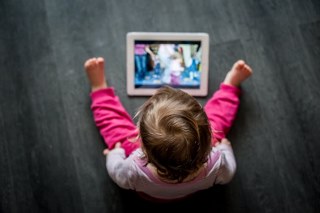
Effects of Technology on Children
When looking at the impact of technology on children, let’s talk about the positives first!
Increased Access to Information
It’s remarkable how easily accessible information has become in today’s world. Children now have a wealth of learning resources available to them anytime, anywhere, which encourages a love for learning from an early age and promotes lifelong curiosity.
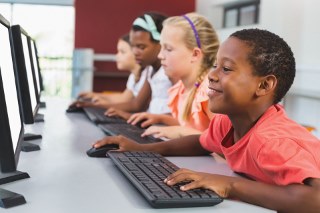
When I was young, finding resources was more difficult and often came with a cost. I can’t help but wonder how having access to such a vast pool of current knowledge might have enhanced my learning.
Technology Literacy
In today’s world, technology literacy is a must-have skill for everyone, starting from childhood. Babies are born into a technology-based world. Kids are quite comfortable asking “Alexa” for help with their homework and can navigate any smart phone, TV, or tablet with ease, which is a great place to start from. However, understanding the digital world is key, and that’s where technology literacy comes in.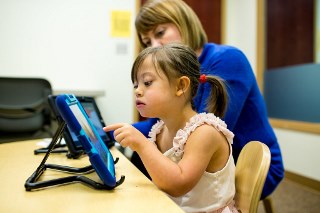 Today technology and media literacy are part of the school curriculum with a goal of helping children to think critically about their consumption of media and marketing so that they can learn how to navigate the digital landscape wisely.
Today technology and media literacy are part of the school curriculum with a goal of helping children to think critically about their consumption of media and marketing so that they can learn how to navigate the digital landscape wisely.
Communication and Socialization
Technology also plays a vital role in a child’s development by fostering communication and socialization. It enables children to stay connected with distant family and friends. Promoting safe interaction on monitored social networking sites ensures a secure environment for socializing without compromising privacy and safety. 
Technology isn’t something we should fear. It was made to make our lives easier; to provide us with convenient solutions for everyday problems. However, it can have some downsides when we let it take too much control. Like anything, it’s all about finding the right balance. I think it’s unreasonable to suggest that children should grow up without any exposure to technology.
So, the question is, what is the right amount of technology/media use and how do we find a healthy balance?
Finding the ‘Just Right’ Amount of Tech
At times, the digital world can be overwhelming, stressful, or even unsafe. In my research, I came across varying screen time recommendations for different age groups of children:
Screen time and young children | Caring for kids (cps.ca)
It is also important to be aware of some ‘red flags’ and to develop strategies for finding the right balance of technology use for children and families.
The following tips can help build healthy digital habits for all of us.
Establishing and Following Screen Time Boundaries
Managing screen time becomes easier when you set and maintain clear boundaries. If kids know they can use digital devices only at certain times and in specific places, they’re less likely to become overly reliant on them. Appointing screen-free zones at home can also help reduce distractions.
Personally, it’s been helpful to leave my phone in another room when I am not using it, especially before bedtime. It helps me avoid endless scrolling and keeps the bedtime blues away, putting my mind more at ease and ready to fall asleep.
Read more: How Electronics Affect Sleep: https://www.sleepfoundation.org/how-sleep-works/how-electronics-affect-sleep
 Recognizing Signs of Problematic Use
Recognizing Signs of Problematic Use
Awareness of children’s digital habits is essential to identifying adverse effects. Indicators such as a lack of interest in other activities, loss of appetite, or stress-related behavior may signal problematic digital media usage. Regular monitoring is key to maintaining a healthy balance.
Having Regular, Open Conversations
Keeping up with Generation Alpha’s tech, slang, and lifestyle can feel like a never-ending challenge. While it’s helpful to know about the tech they’re into, it can be overwhelming for parents to constantly update their gadgets to match their kids’ world. Open conversations can bridge the gap between parents and their children’s online experiences.

Having regular, open talks about social media and online activities with kids creates a safe space to discuss experiences. Encouraging children to share about their online adventures helps parents keep an eye on their safety. Plus, exploring how social media affects emotions can help both parents and kids manage stress and anxiety.
For example, chatting about the kind of stuff they like to see online and how it makes them feel is a good way to understand the impact of technology on children. If they’re not feeling great or safe online, maybe it’s time to tweak their digital habits a bit.
Using Parental Control Settings
While utilizing parental controls and adjusting privacy settings is beneficial, it’s equally necessary to personally guide children through the platform and establish some basic rules for their safety. Educating them on how to report problematic content, identify online scams, and discern safe online chat practices empowers children to navigate the digital world securely.
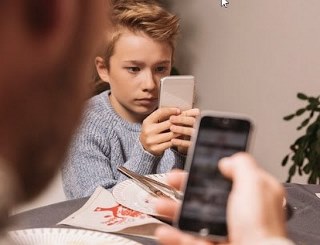
Think about how you educate children for other life skills. Just like teaching them safety measures when they first ride a bike, or sharing tips and tricks that helped you, it’s similar when preparing kids for challenges in the online world. Knowing they have your guidance allows your children to confidently explore online spaces.
Safety is an important consideration and being online savvy can ensure our financial, mental, and physical well-being. So, the sooner we help kids understand and use strategies to keep themselves safe online, the better.
Engaging with Children and Developing Their Critical-Thinking Skills
It’s understandable when parents turn to technology for entertainment; there’s no right or wrong in that. In our hectic work lives and jam-packed schedules, tech can indeed be a lifesaver. However, if we manage to set aside time to engage with children while they’re online, guiding them to evaluate and analyze, it can help them and us to further develop critical thinking skills. Recognizing what’s real and what’s edited will help foster a healthy mindset.
Here are some questions to ask children while they are interacting with digital content:
“What do you like about this picture or video?”
“Does it make you happy or sad?”
“What do you think might be misleading in this video or photo?”

The right amount of tech varies from one family to another; some kids may easily manage technology use while others might need more support. Parents should understand these differences and work with kids to set up healthy habits. Parents also need to recognize when they themselves feel overwhelmed by the online world.
Finding a balance between online and offline activities is key. With technology becoming more pervasive, it’s understandable that offline life may seem less appealing. Let’s consider some ways to make offline activities more enjoyable.
Making Life “Offline” More Interesting
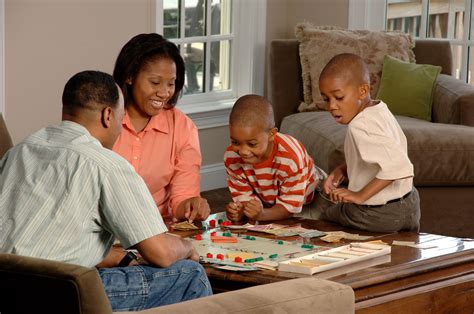 The environment influences a child’s learning. By making the spaces children use safe and interesting, exploration and self-discovery naturally follow. However, when this environment is cluttered with distractions like TV, iPads, and mobile phones, it disrupts their natural exploration process. Their focus shifts to these devices, making other activities less appealing and hindering their overall engagement.
The environment influences a child’s learning. By making the spaces children use safe and interesting, exploration and self-discovery naturally follow. However, when this environment is cluttered with distractions like TV, iPads, and mobile phones, it disrupts their natural exploration process. Their focus shifts to these devices, making other activities less appealing and hindering their overall engagement.
Let’s look at some ways to show kids how fun life “offline” can be:
- Find a little time for the outdoors every day, even if it’s just a casual evening stroll. Consider these outdoor moments as part of your daily routine, like mealtimes, to help connect with nature and each other.
- Embrace different weather conditions for outdoor activities, viewing them as opportunities for children to tackle various challenges. Whether playing in the snow, rain, or sun, each weather condition provides unique experiences with valuable lessons. If the kids are properly dressed, and it’s safe, go outdoors!

Read more about the benefits of outdoor play in our blog here: Why and How We Promote Outdoor Play – Upper Canada Child Care

- Be mindful of our actions as children often imitate what they see. If kids see adults scrolling mindlessly on their gadgets, they might reach for a device. Conversely, if they see you reading a book, they might be inspired to pick one up too. It’s not about completely avoiding devices but finding a balance that works for both adults and children.
- Bring the joy of online entertainment into the offline world. If children like certain cartoon characters, consider engaging in pretend play to bring those characters to life. Toys can also play a valuable role in fostering creativity and imagination.

- Involve children in household chores by giving them age-appropriate tasks. This not only keeps them entertained but also contributes to their confidence and skill development and helps your family.
- Establish weekly family traditions or rituals. For example, something like “homemade pizza night” gives an opportunity for everyone to gather, cook, and share a meal together. These moments create a space for laughter and jokes, adding joy and connection to your shared time. Did you know that sharing jokes as a family can contribute to the development of skills in children? Find out here.

You do You!

We understand that parenting is more challenging than ever. The advice online is endless and often conflicting; it can be overwhelming. Just as there’s no one-size-fits-all guide for parenting, it is the same for supervising a child’s technology and media use.
Everyone is navigating, learning, and evolving; so whatever strategies work for your family, embrace them. For instance, when I spoke with my friend about her daughter’s digital habits, she shared that her daughter could use digital media on weekends only. Yet, she also mentioned they are developing a plan to limit screen time overall. 
Parents are the experts when knowing their children’s needs. Once we know the ‘red flags’ to look for, we can see if children are struggling with their current technology and media consumption and then we can find ways to support them in managing it.
 At Upper Canada Child Care, we focus on building connections with others and nature, and we limit technology use in our programs to prioritize activities that build those connections. However, we realize that there are many positive applications of technology within the learning environment, and we access those when it makes sense.
At Upper Canada Child Care, we focus on building connections with others and nature, and we limit technology use in our programs to prioritize activities that build those connections. However, we realize that there are many positive applications of technology within the learning environment, and we access those when it makes sense.
We hope this blog helps families better understand the impact of technology on their lives and that some of the strategies included assist in finding that healthy balance that suits their unique needs.
By Kirti Khanna, Social Media Specialist
References:
https://online.maryville.edu/blog/children-and-technology/